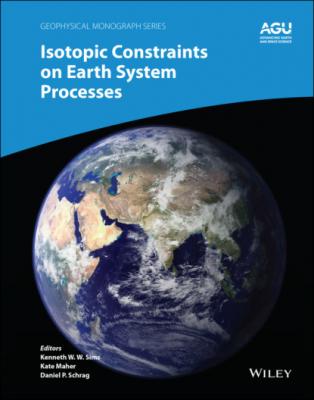Isotopic Constraints on Earth System Processes. Группа авторов
Чтение книги онлайн.
Читать онлайн книгу Isotopic Constraints on Earth System Processes - Группа авторов страница 19
 that were fit with a value of β Mg = 0.045. The weight percent MgO and the isotopic fractionation across the natural felsic‐mafic contact was fit using the same effective diffusion coefficient
that were fit with a value of β Mg = 0.045. The weight percent MgO and the isotopic fractionation across the natural felsic‐mafic contact was fit using the same effective diffusion coefficient Figure 1.5 The panel on the left shows a schematic of the piston cylinder assembly used to anneal juxtaposed melts of mafic and felsic powders made from rocks from the Vinalhaven igneous complex in Maine. The middle panel shows a backscattered electron image of glass recovered after quenching experiment GBM‐2. The panel on the right shows the temperature profile at run conditions extrapolated into the sample using temperatures (black diamonds) measured above and below the sample by the thickness of the spinel that developed in places where MgO and Al2O3 were in contact (see Watson et al., 2002, for a discussion of the spinel thickness temperature monitoring method).
The fact that the magnesium isotopic fractionation across the contact shown in Fig. 1.6 reaches about 3‰, whereas in experiment GBM‐2 the fractionation is somewhat less, does not contradict that the laboratory experiment is a very good analog of the natural system. The reason for the different degree of isotopic fractionation is that the magnitude of the isotopic fractionation depends on both the value of β and the concentration difference driving the chemical diffusion (see Fig. 9 in Richter et al., 2003). The smaller isotopic fractionation in experiment GBM‐2 compared to the natural case is due to the magnesium concentration difference in the laboratory experiment being less than that between the mafic and felsic rocks across the contact in the natural system. The important point is that the isotopic fractionation across a contact between felsic and mafic rocks from Vinalhaven and that found in the laboratory experiment can be explained by effectively the same value of β . This implies that the fractionation in the natural setting was dominantly due to the same simple diffusion process as in the laboratory experiment. Once it had been shown that that the magnesium zoning across the contact between the felsic‐mafic contact at Vinalhaven was due to diffusion, Chopra et al. (2012) went on to estimate a time scale of several hundred days during which diffusion took place with a cooling rate of about 1°C/day for the rocks now exposed at the surface.
Figure 1.6 The upper panel on the left shows the weight % MgO measured along the long axis of the glass recovered from experiment GMB‐2 together with a model curve calculated using an effective binary diffusion coefficient for magnesium that depends on the evolving SiO2 content of the melt. The lower panel on the left uses open circles with two sigma error bars to show the δ26Mg‰ of thin slabs cut perpendicular to the long axis of the glass recovered from experiment GBM‐2. The two black diamonds in this panel show the δ26Mg‰ of the mafic and felsic powders used to make the diffusion couple. The dashed curve is from a chemical diffusion calculation with δMg = 0.040 while the continuous black curve is from a calculation with δ = 0.040 but which also took into account the thermal isotope fractionation associated with the temperature profile shown in Fig. 1.5. The panels on right the show the weight percent MgO and the magnesium isotopic fractionation across an exposed contact between felsic and mafic rock in the Vinalhaven igneous complex in Maine, USA. The model curves in the panels on the right were calculated in the same way as those on the left except that the isotopic fractionation was fit using δMg = 0.045. The δ26Mg‰ is reported relative to the magnesium isotope standard DSM3 of Galy et al. (2003).
1.4. ISOTOPE FRACTIONATION BY SORET DIFFUSION
It is well known that sustained temperature differences in gases and liquids can measurably fractionate elements and isotopes. The existence of this phenomenon in gases was described theoretically by Enskog (1911) and later confirmed by the experiments of Chapman and Dootson (1917). In the case of liquids, thermal diffusion was first demonstrated experimentally by Soret (1879) who found that ionic salts dissolved in water became measurably enriched at the cold end of an imposed temperature gradient. There have also been studies involving silicate liquids (see, for example, Lesher & Walker, 1986), in which Soret diffusion caused some components (e.g., CaO, MgO, FeO) to become enriched in the colder end of a temperature gradient, while other components (e.g., SiO2 and alkali oxides) became enriched in the hot end. The earliest evidence of thermal isotope fractionation in a silicate liquid appears to be the study by Kyser et al. (1998), who reported oxygen isotope fractionation in some of the diffusion couples from the Lesher and Walker (1986) experiments.
1.4.1. The Soret Coefficient
As mentioned in Section 1.2, the flux equation for a component i in a system that is inhomogeneous in both concentration and temperature can be represented by a pseudo‐binary equation
(1.8)
where